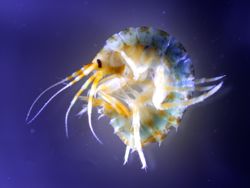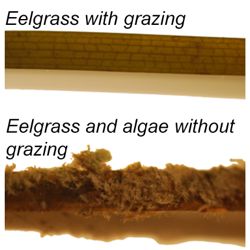Tiny grazers play key role in marine ecosystem health
Tiny sea creatures no bigger than a thumbtack are being credited for playing a key role in helping provide healthy habitats for many kinds of seafood, according to a new study by researchers at the Virginia Institute of Marine Science and the U.S. Geological Survey.

The crustacean “grazers,” some resembling tiny shrimp, are critical in protecting seagrasses from overgrowth by algae, helping keep these aquatic havens healthy for native and economically important species. Crustaceans are tiny to large shelled animals that include crab, shrimp, and lobster.
The researchers found that these plant-eating animals feast on the nuisance algae that grow on seagrass, ultimately helping maintain the seagrass meadows that provide nurseries for seafood. The grazers also serve as food themselves for animals higher on the food chain.
Drifting seaweed, usually thought of as a nuisance, also plays a part in this process, providing an important habitat for the grazing animals that keep the seagrass clean.
“Inconspicuous creatures often play big roles in supporting productive ecosystems,” says Matt Whalen, the study’s lead author who conducted this work while a Master’s student in William & Mary’s School of Marine Science at VIMS.
Whalen, now a Ph.D. student at the University of California Davis, adds “Think of how vital honeybees are for pollinating tree crops or what our soils would look like if we did not have earthworms. In seagrass systems, tiny grazers promote healthy seagrasses by ensuring algae is quickly consumed rather than overgrowing the seagrass. And by providing additional refuge from predators, fleshy seaweeds that drift in and out of seagrass beds can maintain larger grazer populations and enhance their positive impact on seagrass.”
USGS scientist Jim Grace, a study coauthor, emphasized that seagrass habitats are also quite beneficial to people.
“Not only do these areas serve as nurseries for commercially important fish and shellfish, such as blue crabs, red drum, and some Pacific rockfish, but they also help clean our water and buffer our coastal communities by providing shoreline protection from storms,” says Grace. “These tiny animals, by going about their daily business of grazing, are integral to keeping seagrass beds healthy.”
In fact, the authors wrote, if not for the algal munching of these grazers, algae could blanket the seagrasses, blocking sunlight and preventing them from photosynthesizing. Seagrass declines in some areas are attributed partly to excessive nutrients in water bodies stimulating excessive algal growth on seagrass blades.

“Coastal managers have been concerned for years about excess fertilizer and sediment loads that hurt seagrasses,” says VIMS Professor and coauthor J. Emmett Duffy. “Our results provide convincing field evidence that grazing by small animals can be just as important as good water quality in preventing nuisance algae blooms and keeping seagrass beds healthy.”
The scientists involved in the study are members of the Zostera Experimental Network (ZEN), a global, VIMS-led consortium of researchers examining seagrass health. Their research is the first in a series of ZEN-related studies of seagrass ecosystems worldwide.
The study, “Temporal shifts in top-down versus bottom-up control of epiphytic algae in a seagrass ecosystem,” was published in the recent issue of Ecology, the flagship journal of the Ecological Society of America.
